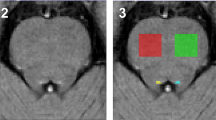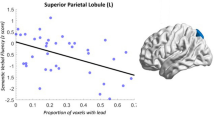Abstract
The neural correlate of anterograde amnesia in Wernicke–Korsakoff syndrome (WKS) is still debated. While the capacity to learn new information has been associated with integrity of the medial temporal lobe (MTL), previous studies indicated that the WKS is associated with diencephalic lesions, mainly in the mammillary bodies and anterior or dorsomedial thalamic nuclei. The present study tested the hypothesis that amnesia in WKS is associated with a disrupted neural circuit between diencephalic and hippocampal structures. High-density evoked potentials were recorded in four severely amnesic patients with chronic WKS, in five patients with chronic alcoholism without WKS, and in ten age matched controls. Participants performed a continuous recognition task of pictures previously shown to induce a left medial temporal lobe dependent positive potential between 250 and 350 ms. In addition, the integrity of the fornix was assessed using diffusion tensor imaging (DTI). WKS, but not alcoholic patients without WKS, showed absence of the early, left MTL dependent positive potential following immediate picture repetitions. DTI indicated disruption of the fornix, which connects diencephalic and hippocampal structures. The findings support an interpretation of anterograde amnesia in WKS as a consequence of a disconnection between diencephalic and MTL structures with deficient contribution of the MTL to rapid consolidation.



Similar content being viewed by others
References
Aggleton JP, Brown MW (1999) Episodic memory, amnesia, and the hippocampal–anterior thalamic axis. Behav Brain Sci 22:425–444
Antunez E, Estruch R, Cardenal C et al (1998) Usefulness of CT and MR imaging in the diagnosis of acute Wernicke’s encephalopathy. Am J Roentgenol 171:1131–1137
Army Individual Test Battery (1944) Manual of Directions and Scoring. War Department, Adjutant General’s Office, Washington, DC
Aupée AM, Desgranges B, Eustache F et al (2001) Voxel-based mapping of brain hypometabolism in permanent amnesia with PET. Neuroimage 13:1164–1173
Barcellona-Lehmann S, Morand S, Bindschaedler C et al (2010) Abnormal cortical network activation in human amnesia: a high-resolution evoked potential study. Brain Topogr 23:72–81. doi:10.1007/s10548-009-0124-3
Benson DF, Djenderedjian A, Miller BL et al (1996) Neural basis of confabulation. Neurology 46:1239–1243
Brown MW, Warburton EC, Aggleton JP (2010) Recognition memory: material, processes, and substrates. Hippocampus 20:1228–1244. doi:10.1002/hipo.20858
Caulo M, Van Hecke J, Toma L et al (2005) Functional MRI study of diencephalic amnesia in Wernicke-Korsakoff syndrome. Brain 128:1584–1594
Christie JE, Kean DM, Douglas RH et al (1988) Magnetic resonance imaging in pre-senile dementia of the Alzheimer-type, multi-infarct dementia and Korsakoff’s syndrome. Psychol Med 18:319–329
Colchester A, Kingsley D, Lasserson D et al (2001) Structural MRI Volumetric Analysis in Patients with Organic Amnesia, 1: methods and Comparative Findings Across Diagnostic Groups. J Neurol Neurosurg Psychiatry 71:13–22. doi:10.1136/jnnp.71.1.13
Conturo TE, Lori NF, Cull TS et al (1999) Tracking neuronal fiber pathways in the living human brain. Proc Natl Acad Sci USA 96:10422–10427
Crowder RG (1976) Principles of learning and memory. Lawrence Erlbaum Associates, Hillsdale
Fitzsimmons J, Kubicki M, Smith K et al (2009) Diffusion tractography of the fornix in schizophrenia. Schizophr Res 107:39–46. doi:10.1016/j.schres.2008.10.022
Folstein MF, Folstein SE, McHugh PR (1975) “Mini-mental state”: a practical method for grading the cognitive state of patients for the clinician. J Psychiatr Res 12(3):189–198
Gamper E (1928) Zur Frage der Polioencephalitis haemorrhagica der chronischen Alkoholiker. Anatomische Befunde beim alkoholischen Korsakow und ihre Beziehungen zum klinischen Bild. Dtsch Z Nervenheilk 102:122–129
Greene RL (1989) Spacing effects in memory: evidence for a two-process account. J Exp Psychol Learn Mem Cogn 15:371–377
Halavaara J, Brander A, Lyytinen J et al (2003) Wernicke’s encephalopathy: is diffusion-weighted MRI useful? Neuroradiology 45:519–523
Harding A, Halliday G, Caine D, Kril J (2000) Degeneration of anterior thalamic nuclei differentiates alcoholics with amnesia. Brain 123:141–154
Heiss WD, Pawlik G, Holthoff V et al (1992) PET correlates of normal and impaired memory functions. Cerebrovasc Brain Metab Rev 4:1–27
Hornberger M, Wong S, Tan R et al (2012) In vivo and post-mortem memory circuit integrity in frontotemporal dementia and Alzheimer’s disease. Brain 135:3015–3025
Hunter R, McLuskie R, Wyper D et al (1989) The pattern of function-related regional cerebral blood flow investigated by single photon emission tomography with 99mTc-HMPAO in patients with presenile Alzheimer’s disease and Korsakoff’s psychosis. Psychol Med 19:847–855
Jacobson RR, Lishman WA (1990) Cortical and diencephalic lesions in Korsakoff’s syndrome: a clinical and CT scan study. Psychol Med 20:63–75
James C, Morand S, Barcellona-Lehmann S, Schnider A (2009) Neural transition from short to long term memory: an ERP study. Hippocampus 19:371–378
Jernigan TL, Schafer K, Butters N, Cermak LS (1991) Magnetic resonance imaging of alcoholic Korsakoff patients. Neuropsychopharmacology 4:175–186
Jones DK, Catani M, Pierpaoli C et al (2005) A diffusion tensor magnetic resonance imaging study of frontal cortex connections in very-late-onset schizophrenia-like psychosis. Am J Geriatr Psychiatry 13:1092–1099
Kessels RPC, Kopelman MD (2012) Context memory in Korsakoff’s syndrome. Neuropsychol Rev 22:117–131. doi:10.1007/s11065-012-9202-5
Kim M, Kim J, Kwon JS (2001) The effect of immediate and delayed word repetition on event-related potential in a continuous recognition task. Brain Res Cogn Brain Res 11:387–396
Kopelman MD (1995) The Korsakoff syndrome. Br J Psychiatry 166:154–173
Kopelman MD, Wilson BA, Baddeley AD (1989) The autobiographical memory interview: a new assessment of autobiographical and personal semantic memory in amnesic patients. J Clin Exp Neuropsychol 11:724–744
Lechevalier B, Aupee AM, de la Sayette V et al (2000) Function imaging of the hippocampus in Korsakoff’s syndrome. Bull Acad Natl Med 184:1491–1497
Mair WG, Warrington EK, Weiskrantz L (1979) Memory disorder in Korsakoff’s psychosis: a neuropathological and neuropsychological investigation of two cases. Brain 102:749–783
Matsuda K, Yamaji S, Ishii K et al (1997) Regional cerebral blood flow and oxygen metabolism in a patient with Korsakoff syndrome. Ann Nucl Med 11:33–35
Mayes AR, Meudell PR, Mann D, Pickering A (1988) Location of lesions in Korsakoff’s syndrome: neuropsychological and neuropathological data on two patients. Cortex 24:367–388
Metzler-Baddeley C, Hunt S, Jones DK et al (2012) Temporal association tracts and the breakdown of episodic memory in mild cognitive impairment. Neurology 79:2233–2240
Moudgil SS, Azzouz M, Al-Azzaz A et al (2000) Amnesia due to fornix infarction. Stroke 31:1418–1419
Nahum L, Gabriel D, Spinelli L et al (2011) Rapid consolidation and the human hippocampus: intracranial recordings confirm surface EEG. Hippocampus 21:689–693. doi:10.1002/hipo.20819
Paller KA, Acharya A, Richardson BC et al (1997) Functional neuroimaging of cortical dysfunction in alcoholic Korsakoff’s syndrome. J Cogn Neurosci 9:277–293. doi:10.1162/jocn.1997.9.2.277
Papez JW (1937) A proposed mechanism of emotion. Arch Neurol Psychiat 38:725–743
Perrin F, Pernier J, Bertrand O et al (1987) Mapping of scalp potentials by surface spline interpolation. Electroencephalogr Clin Neurophysiol 66:75–81
Rahme R, Moussa R, Awada A et al (2007) Acute Korsakoff-like amnestic syndrome resulting from left thalamic infarction following a right hippocampal hemorrhage. Am J Neuroradiol 28:759–760
Reed LJ, Lasserson D, Marsden P et al (2003) FDG-PET findings in the Wernicke–Korsakoff syndrome. Cortex 39:1027–1045. doi:10.1016/s0010-9452(08)70876-1
Regard M, Strauss E, Knapp P (1982) Children’s production on verbal and non-verbal fluency tasks. Percept Mot Skills 55:839–844
Renou P, Ducreux D, Batouche F, Denier C (2008) Pure and acute Korsakoff syndrome due to a bilateral anterior fornix infarction: a diffusion tensor tractography study. Arch Neurol 65:1252–1253
Rossell SL, Price CJ, Nobre AC (2003) The anatomy and time course of semantic priming investigated by fMRI and ERPs. Neuropsychologia 41:550–564
Schnider A (2008) The confabulating mind. How the brain creates reality. Oxford University Press, Oxford
Schnider A, Nahum L, Pignat JM et al (2013) Isolated prospective confabulation in Wernicke–Korsakoff syndrome: a case for reality filtering. Neurocase 19:90–104
Smith SM, Nichols TE (2009) Threshold-free cluster enhancement: addressing problems of smoothing, threshold dependence and localisation in cluster inference. Neuroimage 44:83–98. doi:10.1016/j.neuroimage.2008.03.061
Smith SM, Jenkinson M, Woolrich MW et al (2004) Advances in functional and structural MR image analysis and implementation as FSL. Neuroimage 23(Suppl 1):S208–S219
Smith SM, Jenkinson M, Johansen-Berg H et al (2006) Tract-based spatial statistics: voxelwise analysis of multi-subject diffusion data. Neuroimage 31:1487–1505
Smith SM, Johansen-Berg H, Jenkinson M et al (2007) Acquisition and voxelwise analysis of multi-subject diffusion data with tract-based spatial statistics. Nat Protoc 2:499–503. doi:10.1038/nprot.2007.45
Snodgrass JG, Vanderwart M (1980) A standardized set of 260 pictures: norms for name agreement, image agreement, familiarity, and visual complexity. J Exp Psychol Hum Learn Mem 6:174–215
Squire LR, Amaral DG, Press GA (1990) Magnetic resonance imaging of the hippocampal formation and mammillary nuclei distinguish medial temporal and diencephalic amnesia. J Neurosci 10:3106–3117
Sullivan EV, Marsh L (2003) Hippocampal volume deficits in alcoholic Korsakoff’s syndrome. Neurology 61:1716–1719
Sullivan EV, Pfefferbaum A (2009) Neuroimaging of the Wernicke–Korsakoff syndrome. Alcohol Alcohol 44:155–165. doi:10.1093/alcalc/agn103
Thurstone LL, Thurstone TG (1962) Primary mental abilities (Rev.). Science Research Associates, Chicago
Victor M, Adams RD, Collins GH (1989) The Wernicke-Korsakoff syndrome, 2nd edn. F.A Davis, Philadelphia
Visser PJ, Krabbendam L, Verhey FRJ et al (1999) Brain correlates of memory dysfunction in alcoholic Korsakoff’s syndrome. J Neurol Neurosurg Psychiatry 67:774–778. doi:10.1136/jnnp.67.6.774
Warrington EK, Weiskrantz L (1982) Amnesia: a disconnection syndrome? Neuropsychologia 20:233–248
Wechsler D (1945) A standardized memory scale for clinical use. J Psychol 19:87–95
Welsh KA, Butters N, Mohs RC et al (1994) The consortium to establish a registry for Alzheimer’s disease (CERAD). Part V. A normative study of the neuropsychological battery. Neurology 44:609–614
Wijnia JW, Goossensen A (2010) Cerebellar neurocognition and Korsakoff’s syndrome: an hypothesis. Med Hypotheses 75:266–268. doi:10.1016/j.mehy.2010.02.035
Yoneoka Y, Takeda N, Inoue A et al (2004) Acute Korsakoff syndrome following mammillothalamic tract infarction. Am J Neuroradiol 25:964–968
Acknowledgments
Study supported by Swiss National Science Foundation Grant no. 320030-132447 to AS and by the Center for Biomedical Imaging (CIBM) of the Geneva and Lausanne Universities, the EPFL and the Geneva and Lausanne University Hospitals.
Author information
Authors and Affiliations
Corresponding author
Rights and permissions
About this article
Cite this article
Nahum, L., Pignat, JM., Bouzerda-Wahlen, A. et al. Neural Correlate of Anterograde Amnesia in Wernicke–Korsakoff Syndrome. Brain Topogr 28, 760–770 (2015). https://doi.org/10.1007/s10548-014-0391-5
Received:
Accepted:
Published:
Issue Date:
DOI: https://doi.org/10.1007/s10548-014-0391-5




